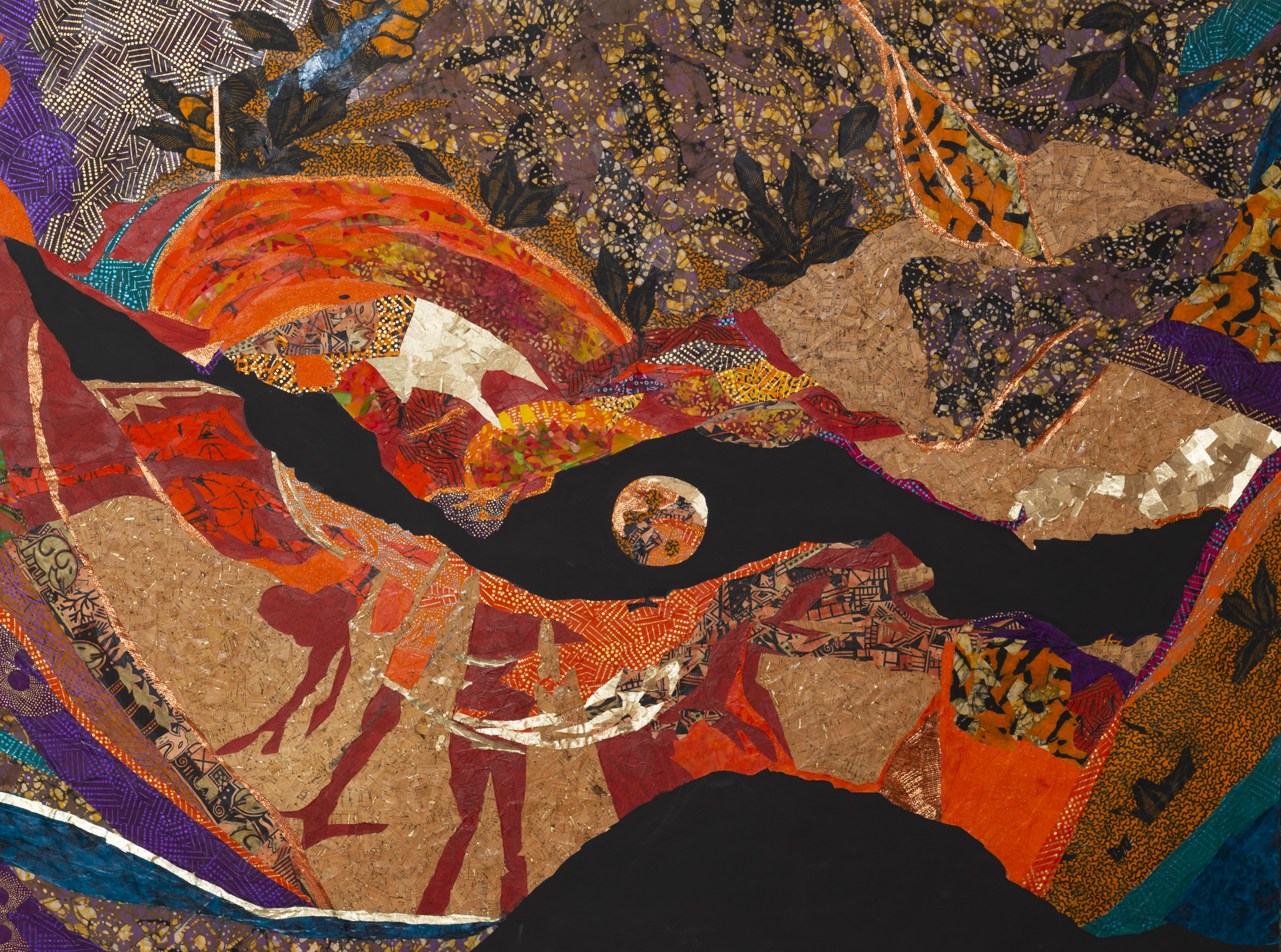Apanaki Temitayo M’s multimedia artwork entitled 'Oju Olorun: Ri Ti Awon Baba' explores African and Indigenous spirituality, land and memories. Read more about the artist and work.

Image description: a multimedia mosiac with earthy browns, rich reds and vibrant purples creates an abstract scene that reminds the viewer of a landscape of rivers, moons and a canopy of trees. The artwork evokes a sense of being stunned by the immense beauty of nature through its movement and fluid shapes.
Artist Statement
Oju Olorun: Rin Ti Awon Baba (Eye of God: Walk of the Ancestors) is inspired by images of rock formations in the Antelope Canyon on Navajo land near Page, Arizona, that bore witness to the deportation and the ethnic cleansing of the Navajo people in 1864. Navajos were forced to walk from their land in what is now Arizona to eastern New Mexico. In 1886, African-American regiments were formed and were dubbed “buffalo soldiers” by the Native Americans they encountered.
In Oju Olorun: Rin Ti Awon Baba, Apanaki strives to connect the spirituality and sacredness of the land in both African and Indigenous spirituality to sense memory of the earth that our ancestors walked, a connection to our histories. This land, through the passage of time, has held the memories of devastation and triumph. To pay homage to past ancestors both Black and Indigenous as a means of reconciliation.
For Oju Olorun: Ri Ti Awon Baba, Apanaki used a combination of recycled fabric, corkwood, art paper and acrylic and used the combined symbolism of the colours in both Yoruba and Navajo culture. The palette of orange and burnt amber reimagine the canyon at night and the power of the Sun and the Yoruba Goddess of Love, Oshun. In Navajo tradition, purple symbolizes wisdom, while in Yoruba, purple symbolizes the Orisha goddess Oya; the Goddess of Death and pivotal change. Green symbolizes life as well as Eshu, the messenger of the Ancestors. The colour blue represents peace and protection and is the symbol of the Great Mother Yemoja.
This series of the sky against the rock formations is a symbolization of nature’s rendering of the God self. Hence, the name Oju Olorun is Yoruba for Eye of God. This unites Turtle Island Indigeneity and African Indigeneity. These mixed media pieces pay homage to the otherworldly nature of the canyon.
About the Artist: Apanaki Temitayo M
 Apanaki Temitayo M is a Toronto-based multidisciplinary multimedia fibre artist and art facilitator. The duality of her name - Apanaki means “Tomorrow Woman” in Mohawk and Temitayo which means “Mine is Worthy of Joy” - celebrates both the Indigenous and African sides of her lineage. Apanaki, whose work has been featured both in Toronto and abroad, uses materials such as African fabrics, cowrie shells and alcohol ink in her work to reflect on a diverse range of topics including spirituality, Black Womanhood, Mental Health and Afrofuturism. Apanaki is the First Artist-In-Wellness for CAMH and an Art Facilitator for the Workman Arts' Art-Cart Program.
Apanaki Temitayo M is a Toronto-based multidisciplinary multimedia fibre artist and art facilitator. The duality of her name - Apanaki means “Tomorrow Woman” in Mohawk and Temitayo which means “Mine is Worthy of Joy” - celebrates both the Indigenous and African sides of her lineage. Apanaki, whose work has been featured both in Toronto and abroad, uses materials such as African fabrics, cowrie shells and alcohol ink in her work to reflect on a diverse range of topics including spirituality, Black Womanhood, Mental Health and Afrofuturism. Apanaki is the First Artist-In-Wellness for CAMH and an Art Facilitator for the Workman Arts' Art-Cart Program.
She has been featured at the World Health Organization: -VERSES- Virtual Exhibition at the United Nations, Apr 2021. She was a Facilitator with the Workman Arts' Art Cart Program and the Textile Museum of Canada, Community Voices Outreach Program. She was the Workman Arts Artist-in-Residence for 2017 - 2018. She has been featured at Workman Arts, Being Scene 18th Annual Juried Exhibition 2019 at the Toronto Media Art Gallery. She made her international debut at the North Charleston Cultural Arts Department, 9th Annual African American Fiber Art Exhibition: Maya Angelou, with her original artwork, Mama’s Watching in South Carolina. Her New York debut at The Amazing Nina Simone Documentary Film by Jeff Lieberman, with her piece Nina Simone Fragmented. She was honoured to be the first woman of colour to be in Room Magazine: Woman of Color Issue for 2016 and her commissioned artwork Oshun Blooming was the face of Grow Room Feminist Literary Art Festival, 2018. Apanaki is currently teaching her art practice at Workman Arts' Encore Program for In-patients, with experience as a facilitator at CAMH, Gifts of Light, Workman Arts' Art-Cart Program, Toronto East General Hospital, Mental Health Out-patient Clinic, Drop-In Art Class and at Workman Arts, CAMH. Rise Asset Development helped to support her in becoming the Sole Proprietor of APNKI Designs. She received an Honorable Mention for 2015 and received the Rise’s Peer Powered EnterpRISEr of the Year Award at the Dr. Paul E.Garfinkel Award for Entrepreneurial Achievement 2015, RISE Asset Development, from Rotman School of Business, University of Toronto, 2015.
Visit her website at apanaki-temitayo-m.pixels.com
ABOUT CRITICAL NARRATIVES- DREAMSCAPES
Critical Narratives are 4 annual publications that feature an original creative work (i.e. audio recording, fiction/non-fiction writing, videotaped performance, photography, documented multimedia piece, etc.) The intention of critical narratives are to encourage artists to question and challenge norms through critical dialogue and art. The Dreamscapes series profiles and explores how artists are envisioning a more sustainable and equitable future.